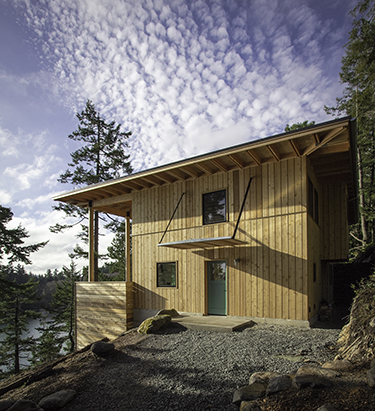|
Subscribe / Renew |
|
|
Contact Us |
|
| ► Subscribe to our Free Weekly Newsletter | |
| home | Welcome, sign in or click here to subscribe. | login |
Real Estate
| |
 |
May 27, 2021
Little houses everywhere: How ADUs will reshape the urban fabric
Johnston Architects

Chaffin
|
A flaw in our urban planning has led Seattle, like many growing cities, into a housing crisis that has translated into congested traffic and long commute times, diminished cultural diversity and for some, homelessness. The flaw is rooted in a lack of planning for supply that meets demand, particularly in affordable housing.
In Seattle, the pressures on housing are increased due to the disproportionate amount of single-family zoning. A water-locked city to begin with, more than half of Seattle’s land is zoned for single-family use only. As a point of reference, Portland’s exclusive single-family zoning is just over 3%. One adaptable way to add density in these areas is accessory dwelling units (ADUs). From attached accessory dwelling units — typically a walk-out basement or renovated attic studio — to detached accessory dwelling units or “back yard cottages,” there are now numerous ways to add housing to residential neighborhoods with formerly very restrictive zoning.
During most historic real estate booms, even those who already own their home can identify as “house-rich but cash-poor.” With most of their wealth locked up in their property, some homeowners become vulnerable to the slightest economic downturn, increasing property taxes, or medical emergency — especially if they are on a fixed income. Using some home equity to build an ADU and establish a rental income can help produce cash flow for individuals, offsetting maintenance and upkeep expenses related to homeownership. These ADUs also increase housing stock and develop an urban environment that is designed to support the varying socioeconomic statuses of all its residents.
MODERNIZING THE ZONING
In 2019, Seattle enacted legislation that removed many of the barriers to creating ADUs. It is not only easier to erect a second dwelling unit on a single-family lot but even encouraged. Seattle has reduced permitting review times for ADUs, implemented pre-approved ADU designs and created a one-stop website called ADUniverse that acts as a dashboard for accessing all the city’s applicable data that is currently available. This includes an interactive map that shows a property owner what is possible to build on their land, making feasibility analysis much easier for those who have never developed property before.
ADU APPEAL
From Lacey to Leavenworth, smaller municipalities around the region are also implementing ADU policies to alleviate housing pressures caused by varying issues, from an uptick in employment to a lack of general development, to the impact of second-home buyers and tourism.
ADUs also provide a solution that meets the needs of the multi-generational housing shift we are experiencing. As our largest generation heads into full retirement, we must be prepared with flexible housing solutions to meet families’ needs. Today’s Generation X adults are often balancing caretaking for elderly parents with parenting their own kids. On the other side of the generational spectrum, we see Baby Boomers taking advantage of their home equity to build ADUs for their adult children to live in or use for extended visits.
Working from home is here to stay for many. In 2020, COVID-19 sent a swath of professionals home to work at kitchen tables, retrofitted garages, or makeshift home offices, and interest in ADUs and smaller second homes skyrocketed. Americans are reimagining the “mother-in-law cottage” in endless ways: backyard offices, gyms and yoga studios, daycares and home learning spaces, and of course longer-term housing for friends and family. People are experiencing the benefits of a work from anywhere lifestyle, boosting the demand for bonus living spaces that ADUs provide.
INDUSTRY RESPONSE
Beginning 30 years ago with small renovations and additions, Johnston Architects (JA) has historically designed single-family projects, both large and small. Our focus shifted over the past few years to the potentials within the ADU typology. Architecture that is efficient, beautiful and intimately connected with its site can provide a solution to a growing housing crisis, and that, to us, is extremely compelling.
At JA, we began thinking about how we, as architects, could streamline the design of ADUs for property owners across our region. We started by creating a simple aesthetic that could be transformed to fit different sized properties, budgets and programmatic requirements. The original prototype, called The Casita, is now sitting in the backyard of our founding partners’ home in Twisp, Okanogan County. Much of the construction was done by JA employees (pre-COVID, of course). By building the prototype ourselves, we were able to find efficiencies and uncover constructability issues that now serve to benefit future iterations of the design.
From the outset, The Casita was meant to be modular both in its structural design and program. The project inspired us to create a parametric digital model to be manipulated based on factors such as number of bedrooms, views, daylighting and energy efficiency. Once we knew what the parameters could be, we began developing a design tool that could be available directly to potential clients looking for ADU solutions.
As we developed the digital model and its modular parts, we also explored ways of making it accessible online for anyone to use. The Parametric Casita was born a few months later. Like its original physical prototype, we built the program all in-house and continue to learn from its existence, evolving its virtual platform to be more user-friendly and incorporate additional design parameters.
While ADUs are not going to solve Seattle’s deficit of affordable housing, they are one part of the solution that can improve the quality of life for people and families of all ages, backgrounds, and in every single-family neighborhood. ADUs are one way individuals can have a hand in helping close the housing gap.
As barriers to building ADUs dissolve in communities throughout the Northwest, tools and technologies make the design and construction of these little homes easier than ever — a democratization of development. These micro-developers — who could be any of us — can become part of a broader group of residents participating in our urban design and policymaking, involving citizens to a degree that is both novel and directly tangible.
Jack Chaffin is a partner at Johnston Architects and leads the firm’s innovation lab, where they develop technology to strengthen design, including daylighting and energy use studies, view analysis, lighting installations and parametric design.
Other Stories:
- Coming soon: A surge of TODs in the Bel-Red corridor
- The many shades of green
- Regional growth: Towns, small cities should choose to lead or be led
- Our city, our time
- Sustainable urban design: connecting community and nature
- Placemaking in pocket parks: Sustaining authenticity in growing urban neighborhoods
- Coming soon: A surge of TODs in the Bel-Red corridor
- Making changes that last generations
- Diverse spaces are key to returning urban cores to normal
- Preparing for Bellevue’s dynamic future
- Infinity Shore Club shows resilience of Seattle market
- Meeting the SE 2050 Challenge



